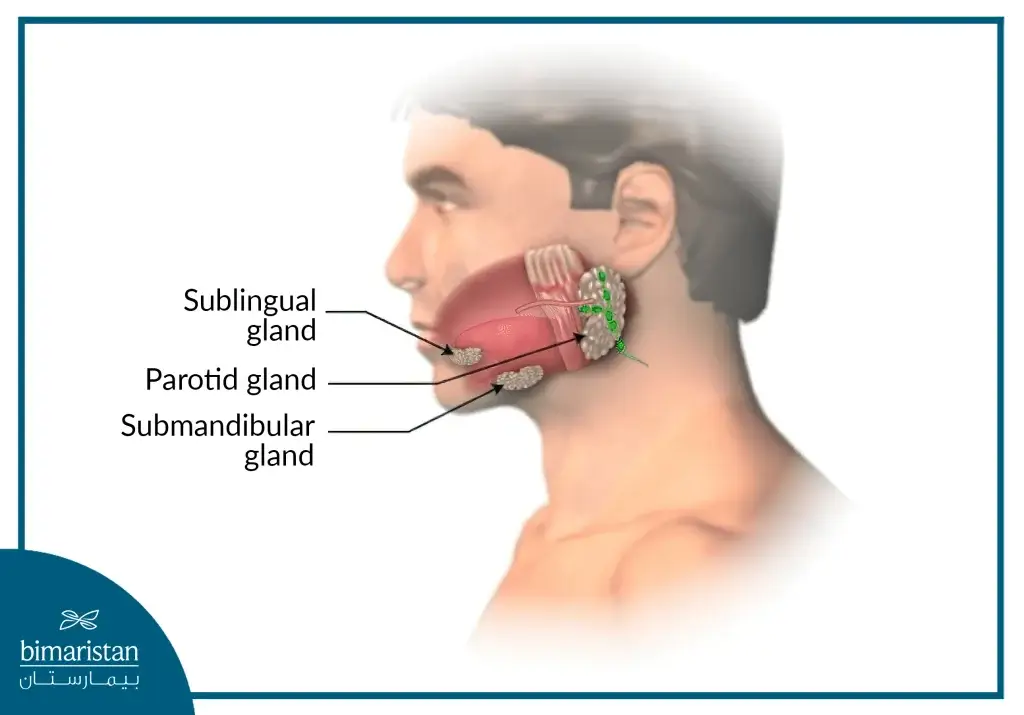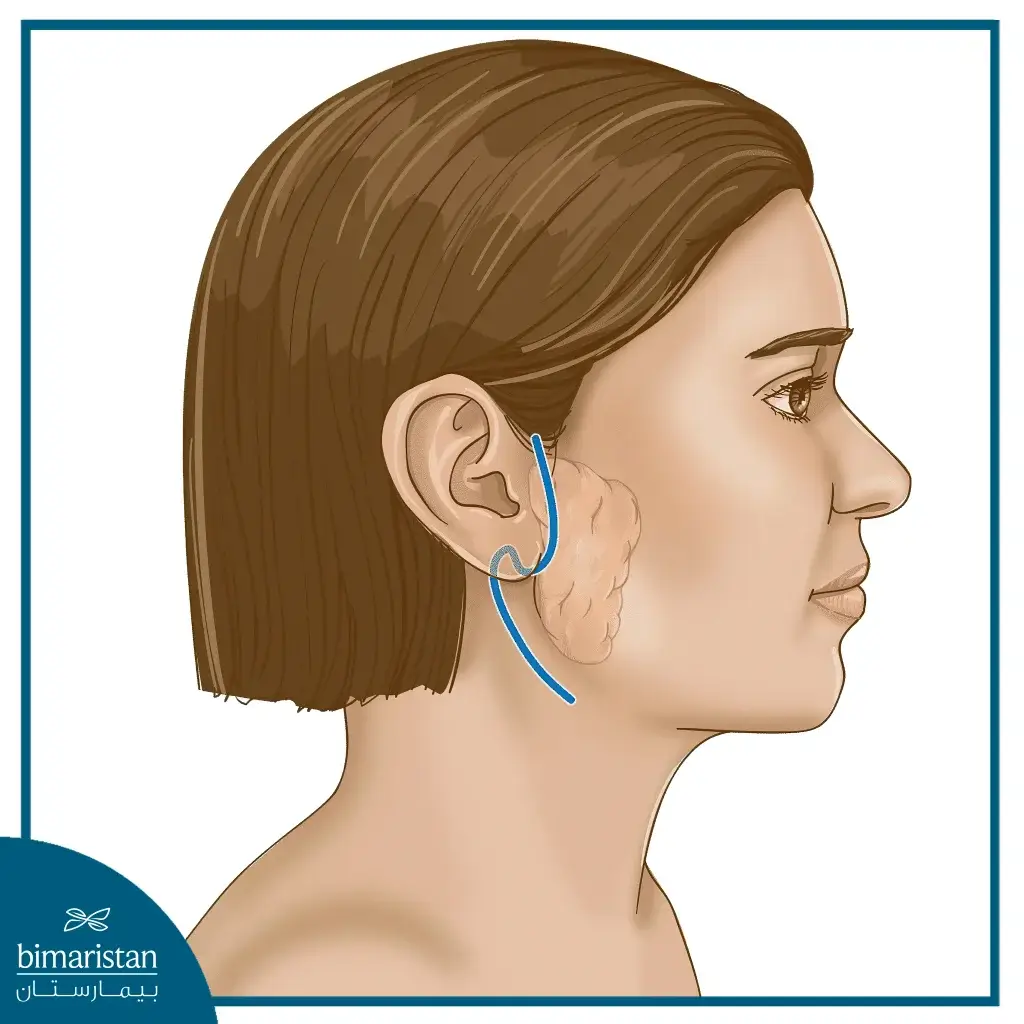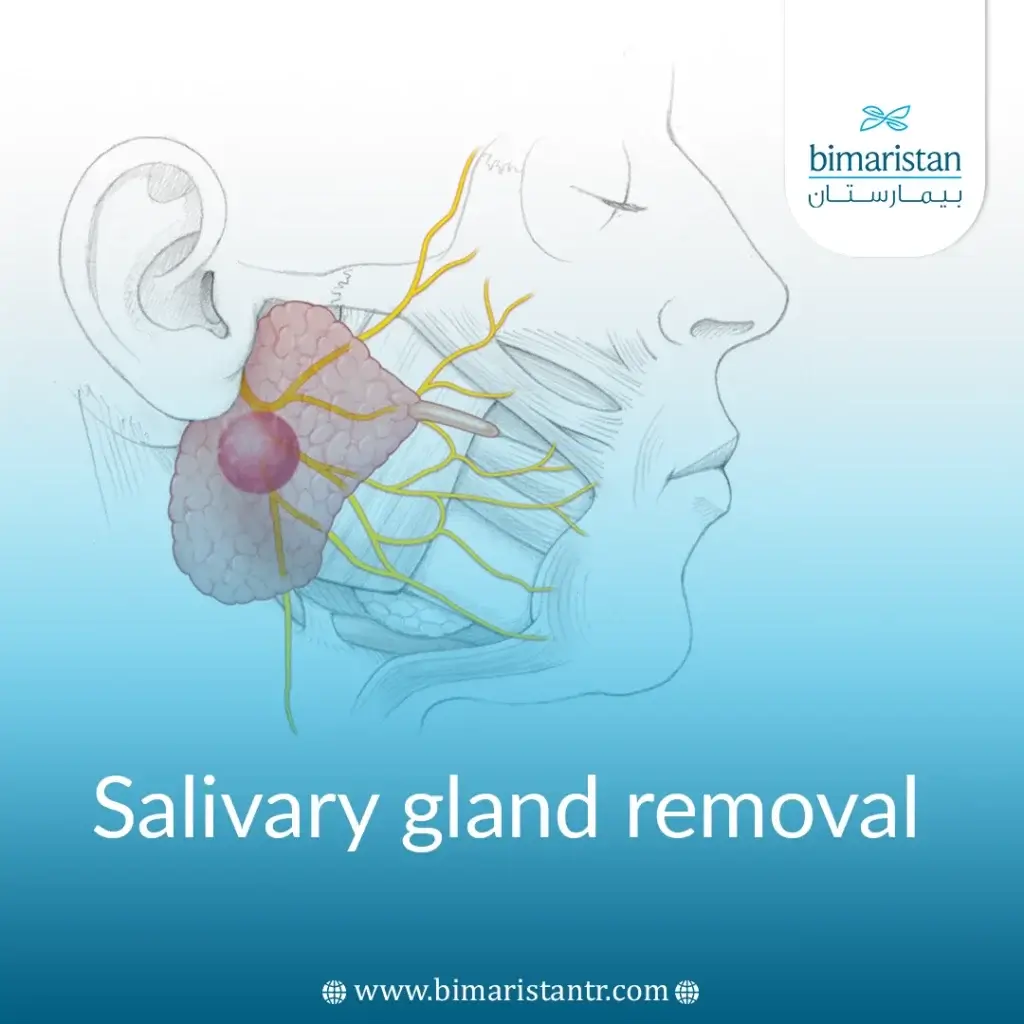Salivary gland removal is surgery to remove all or part of the salivary gland. It is a common operation in Turkey that can be performed with the latest technologies and without leaving a scar.
If a cancerous tumor forms in the salivary gland, you may need a salivary gland removal. This procedure removes the tumor to prevent it from spreading and harming important nearby tissues or structures, such as the facial nerve.
Salivary gland resection surgery is usually the primary treatment recommended for patients with malignant salivary gland tumors, but the surgeon may also recommend radiation, chemotherapy, or a combination of the two, depending on the characteristics and stage of the tumor.
Restorative surgery, dental care, and rehabilitation may also be part of your recovery plan.
In this article, you will learn about the salivary gland removal surgery available in Istanbul, its types, and when you need it.
What is salivary gland removal?
Salivary gland surgery involves removing one of the salivary glands, the glands responsible for secreting saliva in the mouth. A person has minor glands as well as three major pairs of glands:
- Submandibular glands
- Sublingual glands
- Parotid glands

The type of anesthesia required for this surgery depends on the gland to be removed. Local anesthesia will be sufficient if it is a small, minor salivary gland, while surgery for large, major salivary glands, such as the parotid gland, requires general anesthesia.
When do you need salivary gland removal surgery?
Salivary gland removal is usually performed to remove tumors that grow in these glands or due to blockage of their ducts, statistical studies indicate that more than approximately 70% of salivary gland tumors are benign (non-cancerous). However, any mass detected should be examined and usually both types of tumors require removal.
Benign tumors
You may need to have a salivary gland removal to remove benign tumors because they sometimes grow too large and press on and harm neighboring tissues, and certain types of benign tumors can turn into salivary gland cancer.
Malignant tumors
Malignant (cancerous) tumors cause damage to surrounding tissues. They are characterized by their ability to spread to other areas of the body, where cancer cells break away from the original tumor and spread further into the body through the bloodstream or lymphatic system.
Salivary gland cancer may spread to nearby lymph nodes in the neck and then metastasize to other parts of the body.
Additional cancer treatments may include radiation therapy, additional surgeries, including lymph node removal, and reconstructive procedures.
Inflammation and infection
The salivary glands can be affected by several diseases:
Salivary gland stones
Blockage and inflammation of the salivary glands due to the presence of calcified stones. Salivary gland stones are formed when calcium deposits build up in the glands, blocking the flow of saliva into the mouth. This can cause frequent swelling of the glands and infection.
There are several ways to remove salivary stones, such as salivary gland endoscopy, but in some cases, the calcifications are located inside the gland and must be removed.
Salivary gland inflammation
You may also need to remove the gland if you have a salivary gland infection, which can be caused by stones in the gland or by a virus or bacteria.
Before recommending surgery, your head and neck surgeon may order imaging tests such as a CT scan to visualize the submandibular gland and learn more about what’s blocking saliva flow.
Excessive salivation
Your doctor may consider removing the salivary gland to control the condition of hypersalivation (excessive salivation).
This condition can occur in people with neurological conditions that impair control of the muscles of the mouth and face, such as Parkinson’s disease or stroke.
Some medications help control the condition, but if medication is ineffective, the doctor may discuss surgically removing the salivary gland to control excessive salivation, especially if swallowing is difficult. The risk of aspiration of saliva and choking is present.
For some patients, we may not have to remove the gland and just surgically ligate one of the salivary ducts to control excess saliva.
Preparing for salivary gland removal surgery
Before the surgical intervention, the specialist will perform a physical examination, confirm the medications that must be prescribed before the operation, and explain which medications cannot be taken.
Medical examination
Your surgeon will perform a thorough physical examination before surgery and review your past and current medical conditions. The face, neck, jaws, and inside of the oral cavity will be examined for stones, masses, or lesions.
This also includes checking facial symmetry, the function of the nerves that move the corners of the mouth, and asking about medications you take, including herbal medicines and supplements.
Radiography
The examination may require tests using a CT scan of the head and neck or an MRI to plan the surgery and locate the tumor. If the tumor is close to the facial nerve, these diagnostic images help the surgeon plan the best way to remove it without damaging the facial nerve.
Biopsy
If a specialist suspects a tumor, he or she may order a diagnostic biopsy using a thin fine needle FNA to remove a small sample of cells and help diagnose the type of tumor.
A cancerous malignant tumor of the salivary gland will require a different treatment plan.
Salivary gland endoscopy
A procedure used to examine the salivary gland ducts involves inserting a miniature telescope called an endoscope into the opening of the salivary gland duct to explore it. Small instruments can be inserted through the microscope to remove any stones present.
Schedule a salivary gland removal surgery
Once the condition has been diagnosed and the person’s consent has been given, surgery will be scheduled.
You will receive instructions on preparing for salivary gland removal, including what medications you should take or stop taking, when you should stop eating or drinking before surgery, etc.
You may also receive guidance on stopping smoking. Smoking increases your risk of breathing issues during surgery and can slow your recovery afterward.
Salivary gland removal surgery: What happens in surgery?
The surgery itself takes about an hour and a half but the whole process including pre-op preparations and post-op recovery takes about six hours, you will be given local or general anesthesia to make sure you are comfortable throughout the surgery.
The surgeon makes an incision (cut) in the skin crease of the neck below the jaw, where the scar is less visible; the incision may be up to 2 to 3 centimeters long.
The surgeon and team then locate and carefully free the salivary gland from the surrounding tissue and structures. The gland is completely removed, and the wound is closed.
Once you wake up from anesthesia and are examined by your surgeon, you may spend the night in the hospital before being discharged, and you will be given pain medication while you recover at home.
Parotid salivary gland removal surgery
Parotidectomy is the name of the surgery used to remove a benign or cancerous tumor in the parotid glands. This procedure requires the care and expertise of your surgical team to ensure that the facial nerve and other nearby structures are not damaged.
You will undergo the procedure in a hospital or surgery center, and you usually need to stay one to two nights for a parotidectomy.
During the procedure:
- You will be given intravenous anesthesia so that you remain asleep during surgery.
- The surgeon will make an incision starting in front of your ear and extending back and down to the natural crease at the top of your neck; the cutting pattern will help hide the wound once it heals.
- The parotid gland is exposed and the facial nerve is identified to be cautious and avoid damaging it during surgery, a facial nerve monitor may be used to ensure that the facial nerve is functioning properly during surgery.
- If cancer cells have spread to nearby lymph nodes in your neck, all or part of the gland and those nodes are removed.
- Finally, sew the incision.

Your surgeon may insert a small drainage tube to catch any blood or fluid that may collect at the surgery site.
Submandibular salivary gland removal surgery
To treat a benign or cancerous tumor in the submandibular glands, the surgeon removes the affected gland.
Located just below the lower jaw, the surgeon will make an incision below the jawline to remove the gland, and some of the surrounding tissue; the extent of the surgery depends on the size and type of tumor being treated.
Removing the submandibular salivary gland requires precision and skill because there are important nerves nearby:
- The mandibular nerve that helps you smile
- The lingual nerve that allows sensation in the tongue
- The hypoglossal nerve, which allows movement of the part of the tongue that helps with swallowing and speaking
During surgery, your surgeon will try to preserve these and other structures whenever possible, depending on the extent and location of the tumor.
Sublingual salivary gland removal surgery
Sublingual adenoidectomy involves removing the entire gland. These glands are located under your tongue on either side of the floor of your mouth.
The surgeon will cut your mouth to remove the gland along with some of the surrounding tissue; the surgical area is often repaired either by closing the gap with stitches or using a skin grafting technique.
Sublingual salivary gland removal requires precision from the surgeon to avoid damaging the lingual nerve in this area.
The lingual nerve is responsible for sensation and taste on the side of the tongue; a numbness may occur on the affected side of the tongue, usually a temporary numbness that goes away after a few weeks to two months.
Minor salivary gland cancer surgery
Cancer can occur in one of the small secondary salivary glands located in the lips, tongue, roof of the palate, inner cheek, throat, larynx, nose, and sinuses.
Depending on the size and location of the tumor, the surgeon usually removes some of the surrounding tissue.
Lymph node dissection
Salivary gland cancers often spread to the lymph nodes in the neck first before spreading elsewhere.
Therefore, cervical lymph nodes that appear to contain or are likely to contain cancer are often removed along with some other tissue adjacent to the gland during cancer removal.
Salivary gland surgery complications and risks
Salivary gland removal is not a high-risk surgery. However, some precautions must be observed during removal due to its association and proximity to important anatomical sites, the most important of which are these precautions:
Nerve protection
Several important nerves near the salivary glands are carefully avoided by the surgeon during the procedure to avoid traumatizing or damaging them.
Nerves that must be protected during salivary gland removal include:
- Facial nerve
- The lingual nerve that controls the sensation of the tongue
- The sublingual nerve that allows the tongue to move
Damage to these nerves during salivary gland removal can lead to temporary changes in facial muscle movement or impaired sensation in the areas they control, especially if extensive surgical dissection is required around the facial nerve.
Permanent damage to these nerves is a rare complication and usually only results from highly complex parotidectomy cases, while ear numbness is fairly common.
Frey’s syndrome
In some people, the condition may begin several months after surgery, and people with this syndrome develop excessive sweating on the side of the face when eating.
Antiperspirants and Botox injections are suggested treatments for Fry’s syndrome.
First Bite Syndrome
First-bite syndrome involves severe pain with the first bite of food after surgery, and the pain decreases with each subsequent bite.
Botox injections can relax the nerves that cause the pain.
Additional complications
Complications in addition to those described above after salivary gland removal include:
- Bleeding
- Infection
- Scars
- Fluid buildup under the skin that can form a cyst or lump
Other risks that apply to most surgical procedures including salivary gland removal include:
- Allergic reaction to pain medications
- Damage to a nearby organ during surgery
- Fluid collection at the surgical site (seroma or salivary gland swelling)
- Blood pooling at the surgical site (hematoma)
- Infection, bleeding, or scarring
Scars after salivary gland removal, especially parotid, are usually minimal because the incisions are made to fit into the wrinkles of the neck and are challenging to see as the wound heals.
Recovery after salivary gland removal and resection
After salivary gland removal, the specialist will observe the patient’s facial movements and ask them to smile or make facial gestures.
Once home, following your surgeon’s instructions on wound care and hygiene routine is important.
The patient may return to the clinic to remove the stitches a few days after surgery, you may notice some minor bruising, once removed the area should be washed with water and mild soap.
You will be asked to follow wound care instructions, which include keeping the wound site clean and dry and not straining or lifting any heavy objects.
You may have to get used to feeling less sensation in your face and this change is usually temporary.
Discuss with your doctor how the surgery will affect daily activities during recovery, what changes you should expect, and how you can plan for them before undergoing salivary gland removal surgery.
When should I see a doctor?
Don’t delay contacting your doctor if you notice any of the following:
- Pain that can’t be controlled with medication
- Your face feels increasingly numb or weak
- You notice pus, fluid, or blood leaking from the wound
- Your wound feels swollen and painful
- Foul odor at the wound site
Salivary gland removal is a common surgery to remove all or part of the salivary gland due to various glandular diseases; most people have to make adjustments to their daily routine after surgery, such as choosing foods that are easy to chew and swallow and avoiding stress.
Sources:
- Top Doctors
- The Johns Hopkins University
- Memorial Sloan Kettering Cancer Center
